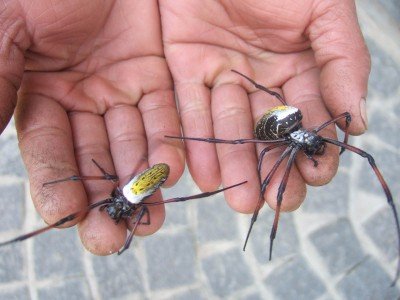 Even before someone told the story of Athena turning Arachne into a spider for besting her in a weaving contest, people have been watching with fascination the work of spiders. Cultures all around the world have gods, goddesses or just stories of spider-creatures who spun and sometimes taught humans to spin thread for clothing and other needs. There is also the story of the spiders of Biblical Egypt who spun their webs across the front of a hollow in a tree to hide Mary and the baby, Jesus, when they were fleeing Herod. In William Henry Hudson's book GREEN MANSIONS, Rima wears a dress made from spider silk, even though in the movie Rima is seen carding wool to spin into thread.
Even before someone told the story of Athena turning Arachne into a spider for besting her in a weaving contest, people have been watching with fascination the work of spiders. Cultures all around the world have gods, goddesses or just stories of spider-creatures who spun and sometimes taught humans to spin thread for clothing and other needs. There is also the story of the spiders of Biblical Egypt who spun their webs across the front of a hollow in a tree to hide Mary and the baby, Jesus, when they were fleeing Herod. In William Henry Hudson's book GREEN MANSIONS, Rima wears a dress made from spider silk, even though in the movie Rima is seen carding wool to spin into thread.
In among all the myths and legends, there exists a real creature that people have been experimenting with to create a special a "spider silk". John Henry Comstock wrote, " The silk of spiders of the genus Nephila surpasses in strength and in beauty that of the silkworm, and it is being utilized to some extent. The more important of the investigations which demonstrated the practicability of using this silk were the following: those made in this country by Professor Burt G. Wilder, with Nephila clavipes; those by Père Camboni, a French Roman Catholic missionary in Madagascar with Nephila madagascariensis; and those by Chinese at Yun-Nan with Nephila clavata.
"Professor Wilder published an account of his experiments in the Proceedings of the Boston Society of Natural History, October, 1865 and in the Atlantic Monthly for August, 1866; but no practical application has been made of them in this country. In Madagascar...the French have founded schools for the instruction of the natives in the methods of rearing the spiders, and in winding, spinning and weaving the silk." (THE SPIDER BOOK, Com-stock)
John Gaggin wrote in his book, AMONG THE MAN-EATERS , the people of the Island of Malicolo in the New Hebrides, made small bags to carry their arrowheads and poison and tobacco from the webs of a spider. He said it was remarkably strong.
In 1887 an obscure California medical journal published a frontier physician's observations on the remarkable properties of silk (here he was talking about true silk - from silkworms). The doctor, George Goodfellow, noted that silk scarves and handkerchiefs were impenetrable to the bullets with which the ne'er-do-wells of Tombstone, Arizona, were shooting one another.
Engineers, biologists, biochemists and physicists have spent lots of time since then researching the mystery of silk's resilience. Most research focused on silkworms. Spider silk, however, turned out to be an even better material for warding off projectiles.
Nephila silk is pretty amazing stuff. It has a tensile strength almost as great as steel's per unit volume and far greater than steel's per unit weight. Kevlar is three times harder to break than Nephila silk, but the spider silk is five times more elastic. Kevlar stops bullets by brute force; Nephila silk stops flies by stretching without breaking. Dragline silk ( the spider silk which forms the frame of the spider's web, radiating from the center to support the capture-silk threads ) has more energy-absorbing capability than Kevlar and can absorb up to ten times more energy.
Industrial interest in producing artificial spider silk has led to the cloning of certain spider genes that specify the proteins, called fibroins, that make up the silk. Researchers in New York state have inserted the cloned genes into goats and then "harvested" the proteins from the goat's milk. Also work was done in tobacco and potato plants which secrete the proteins in their leaves. Work has not progressed into the textile area yet, although an article published about ten years ago talked about dresses that would cost $10,000, and Adam Summers talked about "bulletproof t-shirts" (Summers, "Got Silk?" , NATURAL HISTORY). In the Paris Exposition in the mid-1860's, a complete set of bedhangings made from the silk of Nephila was exhibited.
Isn't it amazing that we are still watching spiders make their webs and wondering if we can use their wondrous silk. We now use cloning and electronic microscopes, but we are still copying and observing nature and seeing the wonderful things it creates on its own.
Bibliography:
Kunzig, Robert. "Arachnomania", DISCOVER . Sept. 2001. Pg 26.
Summers, Adam. "Got Silk?", NATURAL HISTORY . Jul-Aug, 2001. Pg 64.
Whiting, Gertrude. OLD-TIME TOOLS & TOYS OF NEEDLEWORK . Dover Publications. New York. 1971.

